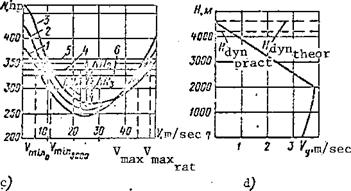Variation of Vertical Rate of Climb with Altitude
If we calculate the power required for horizontal helicopter flight at various altitudes and construct curves of these powers, and if we find the power available at various altitudes from the engine altitude characteristics,
then we can use these curves to draw important conclusions on altitude variation of the helicopter flight characteristics.
Let us examine such curves for the Mi-1 helicopter (Figure 69a). We see from the curves that:
1) for flight speeds less than optimal the power required curves are
shifted upward;
2) for flight speeds greater than optimal these curves are shifted
downward;
3) the power available lines shift upward up to the critical altitude of
2000 meters and then shift downward; this shift causes increase of the maximal speed up to the critical altitude and reduction at altitudes above critical;
4) there is an increase of the minimal speed and an initial increase and
subsequent decrease of the excess power (see Table). We obtained these data using rated engine power. If takeoff power is used, vertical climb can be performed up to an altitude of about 1000 m, and the maximal speed at sea level will be about 210 km/hr.
ALTITUDE VARIATION OF FLIGHT CHARACTERISTICS
|
H. M |
^шзх» kn/hr |
^m’n» -km/hr ‘ |
л N. .hn’ |
Vyt km/hr |
|
0 |
166 ‘■ |
• 18 |
ICO |
3,4 |
|
. 2000 |
ISO |
25 |
110 |
3,8 |
|
3000 |
169 • |
40 |
– 63 |
2,2 |
|
4000 |
‘ 150 |
. 58 |
30 |
1 |
The tabular data can be used to plot two graphs which characterize the helicopter flight characteristics:
![]() the vertical rate of climb; the maximal and minimal speeds.
the vertical rate of climb; the maximal and minimal speeds.
|
|
|
Figure 69. Helicopter aerodynamic characteristics: |
1,2,3- Nh; 4 – Navail for H = 0; 5 – for
H = 2000 m; 6 – N.. for H = 3000 m. avail
The plot of vertical rate of climb versus altitude (Figure 69b) shows that the vertical rate of climb increases up to the engine critical altitude. Above this altitude the rate of climb decreases.
The altitude at which the vertical rate of climb for flight along an inclined trajectory equals zero is called the helicopter dynamic ceiling.
More precisely, this altitude is called the theoretical dynamic ceiling.
Since the helicopter does not actually climb to this altitude, the practical
ceiling concept is introduced, at which the vertical rate of climb equals
0. 5 m/sec. The maximal and minimal speed plot (Figure 69c) shows the increase of the helicopter maximal horizontal flight speed with altitude increase from zero to the engine critical altitude. At altitudes above critical the maximal speed decreases. The minimal speed increases with increase of the altitude.
At the dynamic ceiling altitude, the helicopter can perform flight only at a single speed, which will be both maximal and minimal at the same time. During flight at altitudes less than the dynamic ceiling, the helicopter has a range of speeds in horizontal flight from minimal to maximal.
Figure 69c shows two curves: one of them corresponds to flight using
rated engine power ; the other corresponds to use of takeoff engine power. In the latter case, we see the helicopter static ceiling, i. e., the maximal altitude for helicopter hovering out of the air cushion effect.
The graph showing the variation of the maximal and minimal horizontal flight speeds as a function of altitude is called the helicopter aerodynamic "passport". This "passport" characterizes the helicopter flight data. In many cases, the flight characteristics have various limitations, which ensure structural strength or an acceptable vibration level. Thus, for the Mi-1 helicopter, the maximal flight speed must not exceed 170 km/hr at altitudes from 0 to 3000 meters.
![]() The ceiling of the Mi-1 is limited to an altitude of 3000 meters.
The ceiling of the Mi-1 is limited to an altitude of 3000 meters.
‘Xj
Record speeds for light helicopters (V = 210 km/hr and H ‘ь 6000 m) have been established during flight tests and in special flights on the Mi-1 helicopter.
If the vertical rate of climb is used to calculate the time to climb to various altitudes, we can plot the so-called climb barogram, which also characterizes the helicopter flight characteristics (Figure 69d).















